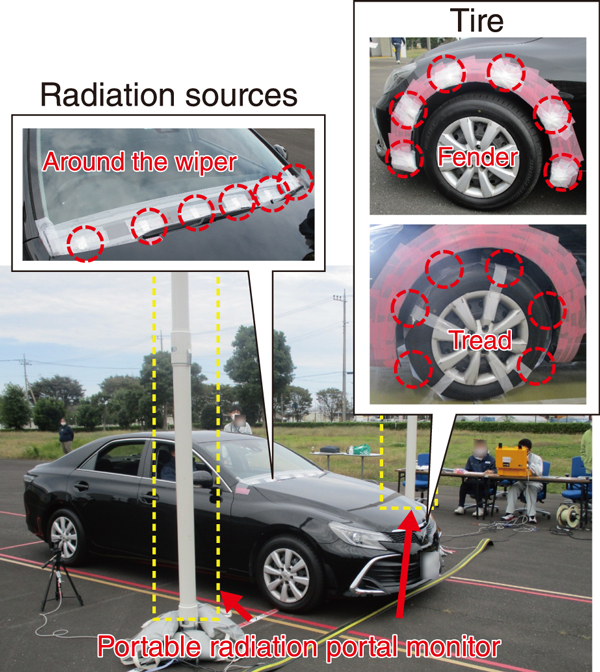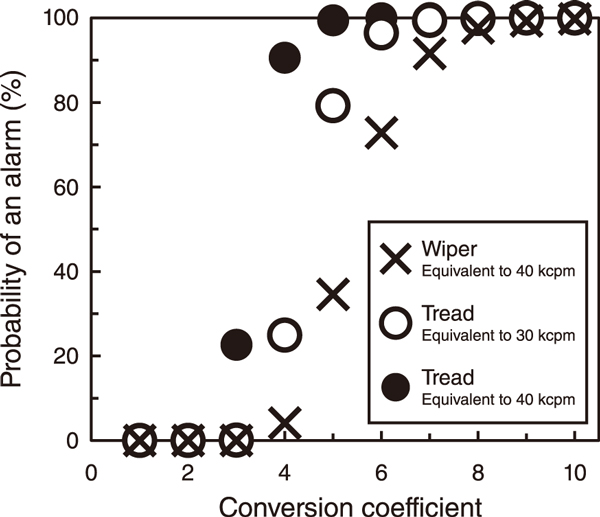
Fig.1 Examination of the portal monitor

Fig.2 Examination results
In a nuclear emergency, the vehicles used by evacuees should be inspected to confirm that there is no contamination on tires and around wipers. However, separate inspection of contaminations on the tires and around the wipers cause a traffic congestion and evacuation delays. To solve this issue, we are developing a method to inspect simultaneously by using a portable radiation portal monitor for vehicles (hereinafter, called “monitor”). In this study, based on the criterion for decontamination (i.e., 40 kcpm with a Geiger-Muller (GM) survey meter), we examined whether contamination on the tires and around the wipers can be identified by the monitor.
First, 133Ba sources were attached to the fender or around the wipers of a vehicle because the gamma-ray energies emitted in a nuclear emergency lie between the energies of 133Ba and 131I, which is one of the major radionuclides released in a nuclear emergency. We measured the count rates of gamma-rays from the sources with the monitor (Fig.1). The manual published in 2017 by the Secretariat of the Nuclear Regulation Authority states that tire treads are targets of contamination inspection in the nuclear emergency. However, it is not possible to drive vehicle with sources attached to the tread. Hence, we measured the count rates from sources attached to the fender of the vehicle while moving and those from sources attached separately to the tread and fender of the vehicle while it remained stationary. Subsequently, we estimated the count rate for the tread of the vehicle while moving from the ratio of the two count rates of the tread and the fender for the stationary vehicle. Then, we converted to the count rate equivalent to the GM survey meter (GM equivalent) using the below equation.
GM equivalent = count rate × conversion coefficient
Finally, we calculated the GM equivalent by varying the conversion coefficient and then computed the probabilities of raising an alarm for the tread and around the wipers. Here, since the count rates attributed to the contamination of the tires and around the wipers cannot be distinguished, we calculated the GM equivalent using the same conversion coefficient.
When the contamination corresponds to a GM equivalent of 40 kcpm (the decontamination criterion), it is necessary to raise an alarm with high probability. In contrast, a false alarm should be provided with a low probability if a GM equivalent is below the criterion. From the examination results given in Fig.2, it is observed that tread contamination exceeding the criterion for decontamination can be recognized by setting the conversion coefficient to 4. However, for this conversion coefficient value, the probability of raising an alarm is below 10% for the case that contamination around the wipers exceeds the criterion. The different probabilities of raising an alarm for the same conversion coefficient are possibly due to the differences in the distances of the monitor from the wipers and the tires.
In this study, we examined the performance of contamination detection by the monitor, and revealed the problems related to system configuration and data-processing methods to distinguish contamination on the tires and around the wipers. The developments achieved in this study will lead to advances toward the goal of simultaneous contamination inspection of tires and wipers of vehicles by using the monitor.
This study was partly commissioned by the Cabinet Office, Government of Japan.
(Hirokazu Hiraoka)
<Previous: 11 Research on Nuclear Safety and Emergency Preparedness | Next: 11-2>